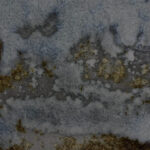Index
- What are low-emission digital inks?
- Chemical principles and emission reduction
- Types of low-emission inks
- Operation in digital ceramic printing
- Benefits for ceramic laboratories
- Regulatory compliance and certifications
- Practical applications and use cases
- Conclusions
- Faq
Low-emission digital inks: sustainable solutions for modern ceramic factories
Low-emission digital inks are changing the way ceramic factories work, offering a concrete solution for those seeking sustainability without compromising on performance.
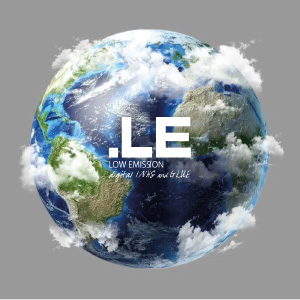
These inks drastically reduce the harmful substances emitted during printing and firing, helping technicians to protect the health of operators and improve the quality of the working environment.
Thanks to the development of advanced lines such as Sicer’s .LE series, it is now possible to print ceramic collections in bright colors, also relying on the expansion of four-color printing with new shades of red and yellow. Working with low-emission digital inks is a choice that is good for the environment and meets the latest technical requirements.
What are low-emission digital inks?
Low-emission digital inks represent a new frontier for those working in ceramic laboratories and factories.
These products are carefully designed to minimize the release of harmful substances into the air, improving both the working environment and the sustainability of the entire supply chain.
The real innovation lies in their chemical approach: new formulations allow printing without strong odors and with fewer risks for operators, leading ceramics towards an increasingly clean future that respects both people and the environment.
Chemical principles and emission reduction
The strength of low-emission digital inks comes from cutting-edge chemical formulations that focus on one goal: drastically reducing volatile organic compounds (VOCs), aldehydes, and formaldehyde during preheating and firing in kilns. This is achieved through the use of ultra-refined solvents, developed to evaporate only at the high temperatures reached in the kiln, and the development of water-based inks with virtually zero VOC emissions and a total absence of unpleasant odors.
The results? Under real production conditions, there is a reduction in VOC emissions of up to 50% compared to traditional inks. Laboratory tests on a modern production line confirm:
| Ink type | VOC emissions (relative value) | VOC reduction compared to traditional ink |
| Traditional ceramic ink | 100% | — |
| Low-emission ink | 50% | 50% |
This difference immediately translates into cleaner air and a working environment where it is easier to breathe, protecting the health of operators and complying with the latest regulatory limits.
Types of low-emission inks
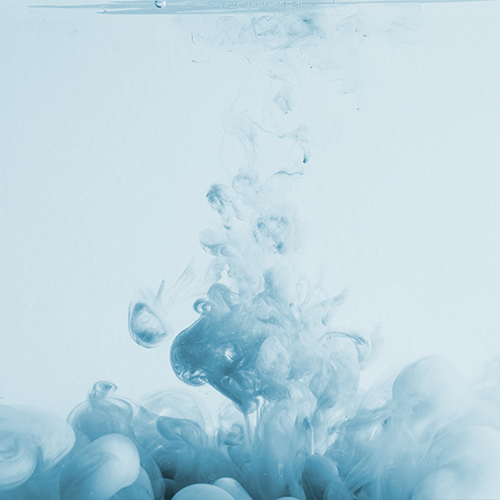
There are two main families of low-emission digital inks on the market, both capable of meeting different production and quality requirements:
Water-based inks
These are the ideal choice for those looking for a completely odorless solution that significantly reduces VOC emissions. Perfect for those who want healthy work environments and maximum sustainability.
ECO solvent-based inks
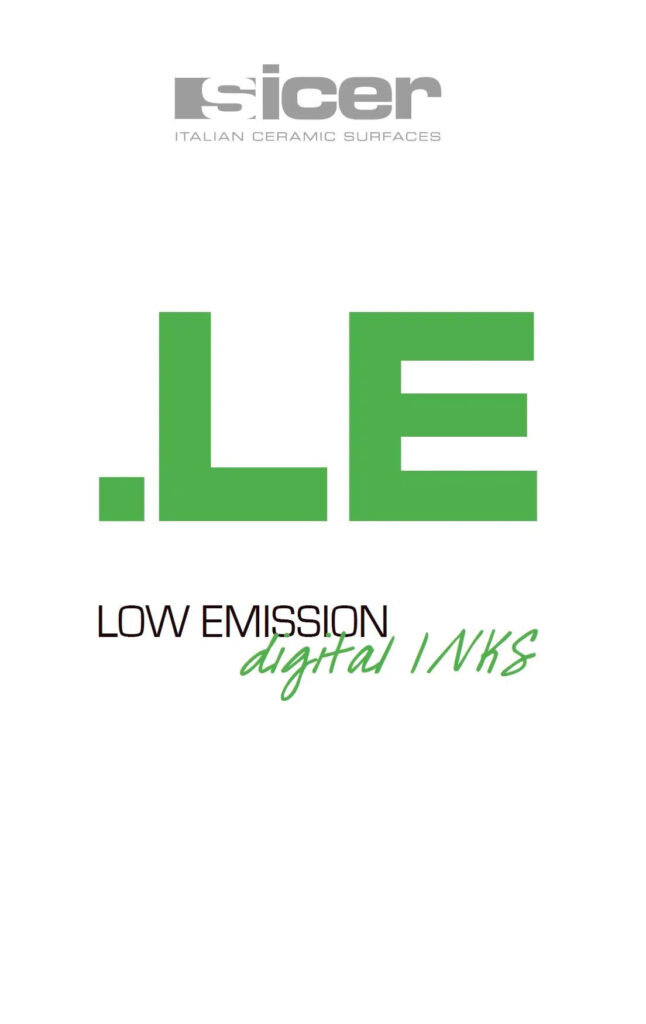
these products use ultra-refined, new-generation solvents. Despite the presence of an organic component, these formulations are designed to drastically limit odor emissions while maintaining high-level color performance and operational stability. A concrete example that is already widely used in leading ceramic studios is the LE Series Low-Emission Inks line, which offers base colors for four-color printing and new colors such as red and yellow, useful for expanding the color range without compromising efficiency or environmental friendliness.
These solutions make a difference in the modern world of digital ceramics, guaranteeing impeccable aesthetic results and a significantly reduced environmental impact.
How it works in digital ceramic printing
Low-emission digital inks have transformed the way technicians approach ceramic printing.
Thanks to their innovative formula, these inks behave differently from traditional solutions, offering safety, quality, and sustainability directly on digital ceramic production lines. Let’s analyze how they work in two key moments: deposition on the substrate and the firing phase.
Deposition and preheating phase

At the beginning of the process, the digital ink is deposited evenly on the ceramic surface using special inkjet systems. This is where the low-emission composition makes the difference:
- thanks to refined organic or water-based vehicles, the inks remain stable on the substrate without producing unpleasant vapors or odors during preheating.
- The result is a homogeneous, adherent layer, which is essential for ensuring the color rendering and detail required in collections with high aesthetic value.
This behavior offers two practical advantages: on the one hand, it reduces the formation of unpleasant and annoying odors in the workplace, and on the other, it maintains the brilliance of the shades, even with the expansion of four-color printing, which now permanently includes red and yellow in low-emission digital ink solutions.
Firing and controlled pyrolysis
The real difference between these technologies emerges during firing, when the ceramic panel reaches temperatures above 500°C. At this stage:
- The organic components of the ink do not degrade immediately. The release occurs in the hottest area of the kiln, where the transformation into CO₂ and H₂O is favored.
- Controlled pyrolysis allows for a net reduction in emissions of volatile organic compounds and aldehydes, ensuring safer conditions for workers and less load on air treatment units.
Benefits for ceramic factories
The choice of low-emission digital inks translates into concrete advantages for ceramic laboratories. Technicians not only achieve a real reduction in harmful substances, but also more reliable printing processes, increasingly intense colors, and easier management of production parameters.
The technological innovation applied to these products ensures a cleaner working environment, fewer line interruptions, and impeccable compliance with European sustainability regulations.
Regulatory compliance and certifications
Ceramic companies today must meet stringent environmental standards. In this scenario, the use of low-emission digital inks such as Sicer’s .LE series allows them to work in compliance with the main directives.The .LE series has been developed to meet and exceed all these requirements, making environmental checks and audits easier. The adoption of these inks allows technicians to obtain certifications more quickly and efficiently, reducing the risk of non-compliance and penalties.
Practical applications and use cases
Low-emission digital inks are not just a technical solution, but a real step forward for those who work in ceramic laboratories every day.
Technically reliable, these products easily adapt to the reality of industrial plants and design workshops, bringing concrete innovation and results that are visible to the naked eye. Let’s look at some real examples of how low-emission solutions integrate into production flows and what benefits they offer in practice.
Sicer’s .LE series as a complete solution
Sicer developed the .LE series with the needs of technicians in mind: from color flexibility to the combination of aesthetics and sustainability. The offering is truly comprehensive and stands out for these product lines:
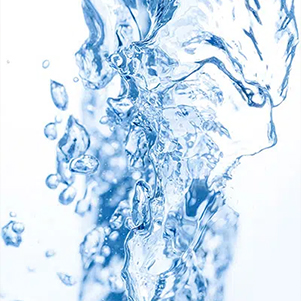
- Primary inks for extended four-color printing, which now include red and yellow. This allows for bright, customized shades with no limits on the choice of palettes. Thanks to this color extension, those working in the laboratory can create unique collections and consistently stable colors, confirming the highest aesthetic results even on high-temperature cycles.
- Digital textured effects: textures, light effects, micro-reliefs, and materiality that increase the perception of depth and make each piece truly original.
- Low-temperature (LT) and high-temperature (HT) digital glue: ideal for the precise application of grit and decorative materials. The water-soluble version combines performance and clean air in the department, offering a sustainable alternative to classic solvent-based solutions. Discover all the technical details on LE low-emission digital glue, specifically designed to meet the demands of those who want to reduce emissions even in digital gluing processes.
From a sustainability perspective, the .LE range allows you to design more environmentally friendly processes without sacrificing color rendering or print quality: technology, the environment, and beauty finally go hand in hand.
Examples of integration into existing processes
One of the strengths of low-emission digital inks is their total compatibility with current production lines. No fixed investments, major adjustments, or delays due to conversion: the introduction of the .LE series is quick, clean, and requires no modifications to existing equipment.
Ceramic laboratories that have incorporated these inks into their processes report:
- Same machines, new results: just change the ink set without changing the hardware or software configuration of the lines.
- Greater cleanliness, fewer downtimes: the low-emission formula avoids residues on digital printer components, cutting maintenance costs and times.
- Adaptability to requirements: the variety of products in the .LE series allows you to handle both large-volume production and special custom jobs without having to change your internal organization.
For those who want to learn more about the transformation made possible by this ecological and productive upgrade, Sicer recounts real cases and practical tests in the article Towards full digital with LE inks: a collection of application scenarios that demonstrate how simple and advantageous it is to switch to more sustainable and modern ceramic production with low-emission digital inks.
The practicality is clear to see: every workshop can plan its own path to sustainability without having to compromise on creativity or production performance.
Conclusions
Choosing low-emission digital inks means focusing on a more sustainable, productive ceramic workshop that complies with the latest regulations.
Reduced emissions, the possibility of working in healthy environments, and compatibility with existing technologies are just some of the concrete advantages for technicians.
With the flexibility of the .LE series and the expansion of the four-color process, which adds new shades such as red and yellow, creative opportunities increase without ever losing sight of the environmental impact.
Those who want to make their process even more efficient and suited to current demands can also find out more about the differences between grits and inks in digital printing in Ceramic grits and inks: key differences.
To complete a truly sustainable process, the digital application of grits can now also count on low-emission solutions.
Sicer has developed Low Emission Digital Glue – Water Based, a water-based digital glue that further reduces environmental impact and improves air quality in production departments.
Thanks to the total absence of organic solvents, this technology integrates perfectly with low-emission digital inks, allowing ceramic laboratories to create decorative surfaces and technical applications in a completely eco-friendly production system, without compromising on performance or aesthetic results.
To turn sustainability into a real opportunity and find the solution that best suits your needs, contact us.
Thank you for reading: every step towards clean printing brings new benefits, today and tomorrow.
FAQ
Reduced harmful emissions (VOCs), healthier working environments, production efficiency, and color stability.
The former do not contain organic solvents and guarantee zero emissions; the latter use ultra-refined solvents with high color performance and reduced emissions.
Yes, it is designed to be introduced without modifications to the systems, ensuring compatibility and ease of integration.
Yes, they comply with directives such as IPPC, AIA, and UNI EN ISO 11890, facilitating certifications and environmental controls.
Although they have a competitive initial price, they reduce downtime, defects, and maintenance, leading to long-term savings.



